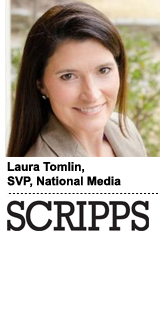
In August, E.W. Scripps reorganized its business into two parts: one division focusing on local media – its bread and butter – and the other on national media channels.
The move unified Scripps’ digital video service, Newsy, with podcast network Midroll, digital audio service Stitcher and satire and humor brand Cracked, under the national media umbrella.
Scripps expanded its national footprint even further in October when it acquired the Katz broadcast networks, which include specialty stations like African-American network Bounce TV and multicast comedy network Laff.
“Now that I’ve started to work more closely with each of these brands and businesses as a whole, we’re looking at ways we can do more portfolio selling,” said Laura Tomlin, SVP of national media for E.W. Scripps.
Although it’s early, Tomlin foresees merging opportunities across digital and cable.
“When you consider the direct-response (DR) advertisers we have with the podcast network or with Newsy, we see an opportunity to bring those digital brands into cable,” she said.
While DR advertisers like mattress brand Casper or online dating service eHarmony primarily leveraged paid media to influence a purchase, they mostly used digital, such as Scripps’ podcasts or OTT video via Newsy, to move the needle.
But now, Scripps’ cable expansion is one more way for brands to acquire more reach.
“These advertisers want to see some sort of activation – somebody bought a mattress or redeemed a code,” Tomlin said. “But the reality is, we’re all making purchases on our iPhone while we’re watching TV, so advertisers are looking for more ways to bring people into the funnel too.”
Conversely, cross-pollinating audiences across properties is an obvious way to build reach for brands.
Although each Scripps property has a distinct audience – Bounce appeals to an older African-American male demographic, while Cracked caters to younger demos interested in comedy – there is some overlap.
For instance, Midroll appeals to younger people interested in podcasts, and Newsy serves millennials.
“Some of our businesses, specifically Newsy and Katz, have been around awhile, and each brand knows their own client and who will buy over-the-air vs. a podcast,” Tomlin said.
“This is a new structure for us, but there’s a lot of opportunity ahead, given the relationship we have with advertisers, to tell [an OTT buyer] that if they want to align with a podcasting brand, or whatever, we can give you that. We can give you scale and give you niche.”
This post was syndicated from Ad Exchanger.

More Stories
Burger on the dancefloor: Spark celebrates free data for Spotify music with exclusive event
Around the World: Elon Musk’s brand freefallin’ and celebrity splits shine in marketing
Daily Wire Welcomes Perplexity to Advertise on The Ben Shapiro Show